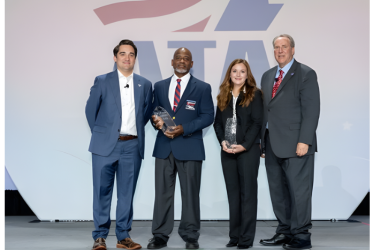In the face of the ever-growing truck parking crisis, a seasoned industry veteran has an interesting solution. Frank Sonzala, with 40 years of experience in trucking and transportation, is spearheading a business plan that could alleviate the challenges posed by the shortage of parking spaces for trucks across the country.
Sonzala’s idea revolves around repurposing abandoned drive-in movie locations and other similar sites near major cities. By transforming these spaces into secure and conveniently located parking facilities, complete with essential amenities such as restaurants, bathrooms, showers, and even recreation areas, Sonzala aims to tackle the truck parking scarcity head-on.
As the chief corporate development officer of ConTrade Holdings, based in San Antonio, Sonzala and his team are currently in the fundraising stage of their plan. With full implementation, they envision creating over 40,000 truck parking spaces, providing a much-needed respite for truck drivers nationwide.
“Trucking parking problems are a national safety concern,” Sonzala said. “This is an epidemic for the truck drivers to find a safe place to park at the end of their duty day. For every driver who finds a legal and safe place to park, we need 11 more parking spaces every day. Now we have about 360,000 legal parking spaces for the trucking industry and we need more than 3 million spaces.”
Sonzala is on a mission to create a nationwide network of convenient parking spots near major cargo hubs. Starting with iconic drive-in movie locations, this company aims to provide you with a stress-free parking experience at a fixed price of $26 per day.
“Our goal is to build 100 of these facilities with 450 stops to start in areas where the congestion is the worst and there is the least amount of truck parking,” he said. “We are already searching out the locations we can buy. We are going to do this in a rapid format.”
Sonzala said that his company is currently exploring multiple potential locations in Texas. They are aiming to establish a new site that will be up and running by the end of this year or possibly early 2024.
“There were once more than 8,000 drive-in movie theaters in the country, now we have 321. They’re between 14 and 15 acres. They have water, electricity, and they’re zoned properly. I know there are 18 of these sites on Interstate 10 between California and Florida,” Sonzala added. “When we build 100 of these, with 450 spots per facility, we will have only solved about 20% of the problem.
I-10 is the fourth-longest highway in the U.S., spanning an impressive 2,450 miles across the country. From the magnificent Pacific Ocean in Santa Monica, it takes you on an unforgettable journey all the way to the stunning Atlantic Ocean in Jacksonville.
“I drove by one of these locations recently near Lubbock, Texas, and me and my family went by an old movie theater location, where I took my wife on our first date,” Texas Trucking Association CEO John Esparza said. “I said to my son I think they’re are going to turn that into some sort of a truck parking facility. The private sector is going to have to help get it done. We need to get it done, and let’s let the private sector do it. We’re set up for that, and we cannot rely entirely on the states alone to solve our parking challenges.”
The federal government is increasing its involvement in truck parking by allocating more than $750 million over three years for various projects. Recently, the Department of Transportation awarded $33.5 million in grants for truck parking facilities in Texas and Louisiana, and $37.6 million was designated for projects in Florida and Tennessee.
One project in Texas, located between Austin and San Antonio, will include 20 short-term and 100 longer term parking spots with security measures and a rest stop featuring showers and restrooms.
According to Bill Sullivan, executive vice president for advocacy at the American Trucking Associations, solving the truck parking shortage will require collaboration between governments at all levels and the private sector, and will likely take several years to complete.
“We have only begun to see at the federal level grants that specifically target truck parking, which is welcome,” said Sullivan. “From an ATA national perspective, policymakers have now turned their attention to this in a major way and we see hope.
“We are a market-based country and so much of this depends on land, and governments will only be able to do so much. The problem is big enough, and private solutions likely have a role to play.”
Sonzala acknowledged that there may be objections from some in the industry regarding his company’s decision to charge truckers for parking. He also recognized that this endeavor might be seen as a rival to the truck stop and travel plaza industry.
“We’re not planning to enter into the fuel and restaurant business,” he said. “What we’re trying to do is be the best in the truck parking business.”
Source: Transport Topics











